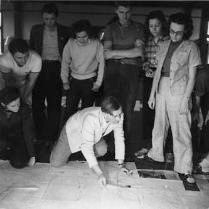ROBERT DE NIRO, SR. was part of the celebrated New York School of post-war American artists. His work blended abstract and expressionist styles of painting with traditional representational subject matter, bridging the divide between European Modernism and Abstract Expressionism.
ROBERT DE NIRO, SR (left) STUDIED WITH HANS HOFMANN, 1939-1942.
EARLY LIFE and EDUCATION
Born in 1922 in Syracuse, New York, Robert De Niro Sr. showed an innate artistic ability, provided with a private studio while attending art classes at the Syracuse Museum from age eleven to fifteen. In the summer of 1938, he studied with the artist Ralph Pearson in Gloucester, Massachusetts.
As a teenager, he studied under two of the 20th century’s leading abstract painters, Josef Albers and Hans Hofmann. From 1939 to 1940 De Niro studied at the renowned Black Mountain College under Albers. While Albers’ highly analytical approach to painting did not appeal to De Niro’s more instinctive style, the experience and international perspective of the Bauhaus master nonetheless left a lasting impression. He left the school after a year and moved to New York City, where he studied with Hans Hofmann during the year and his Provincetown, Massachusetts summer school through 1942. There he met fellow student Virginia Admiral, whom he married in 1942. Hofmann's emphasis on color and his openness to both representational and abstract painting had a strong influence on the development of De Niro’s enduring artistic style.
DE NIRO, SR. (standing center, arms crossed) WITH JOSEF ALBERS AT BLACK MOUNTAIN COLLEGE, circa 1939-1942
FAMILY
De Niro and Admiral surrounded themselves with an illustrious circle of friends, including writers Anaïs Nin and Henry Miller, playwright Tennessee Williams, and Robert Duncan, the editor of Ritual, a literary magazine for which Virginia worked. The couple separated shortly after their son, Robert De Niro, Jr., was born in 1943.
CAREER
During the mid-1940s De Niro burst onto the New York art scene along with a generation of prominent abstract painters. In 1945, De Niro’s art was exhibited at Peggy Guggenheim’s renowned Art of This Century Gallery in New York, the leading gallery for established European modernists and the emerging Abstract Expressionists. Exhibited alongside the work of Jackson Pollock, Mark Rothko, and Clyfford Still, critics praised DeNiro’s compositions filled with improvised areas of vibrant color that gave way to loosely painted still lifes and curvaceous nudes.
In 1946 Peggy Guggenheim awarded De Niro his first solo show, a prestigious honor for a twenty-four year old painter. He continued to exhibit at the Charles Egan Gallery during the early 1950s, where his work was accompanied by the art of Willlem de Kooning and Franz Kline. Employing a feverous process of drawing, wiping, scrapping and blending, De Niro created canvases that were alive with energy and widely popular. By the mid-1950's, DeNiro was regularly included in important group exhibitions, such as the Whitney Annual, the Stable Annual and the Jewish Museum. He received a Longview Foundation Purchase award in 1958.
As the political and cultural climate in America continued to shift in the late 1950s and early 1960s, the art world embraced Abstract Expressionism and the emergence of Pop Art. Figurative expressionist painters, like De Niro, were marginalized to the outskirts of the commercial art world. Frustrated by this shift, from 1961-1964 De Niro Sr. travelled to Paris and the surrounding countryside where he continued to draw inspiration from the European modernists, including Matisse and Bonnard. During this period, from 1958 to 1970, De Niro continued to receive solo exhibitions at the Virginia Zabriskie’s renowned gallery in New York City. Collector Joseph Hirshhorn purchased a number of the artist's paintings and works on paper through the gallery, which are now in the permanent collection of the Hirshhorn Museum and Sculpture Garden in Washington, DC. Following his return to New York, De Niro was awarded a Guggenheim Fellowship in 1968.
WITH VIRGINIA ADMIRAL, circa 1940
LATER CAREER
Throughout his career De Niro remained well known and respected within the art world throughout his career. In the 1970s De Niro became professor, teaching at several art schools including the Cooper Union, the New School for Social Research, the School of Visual Arts, and East Michigan State College. He continued to exhibit in galleries throughout the United States until his death in 1993. Over the course of his nearly fifty year career, De Niro continued to paint mesmerizing landscapes, interiors and figures with distinctly modern abstract shapes of brilliant color and invigorating brush strokes.
Robert De Niro Sr died in 1993.



